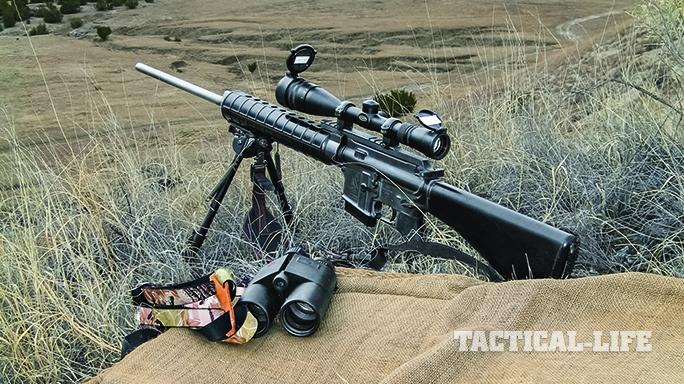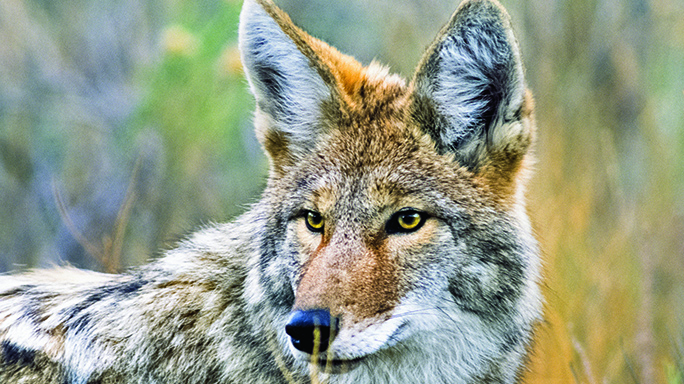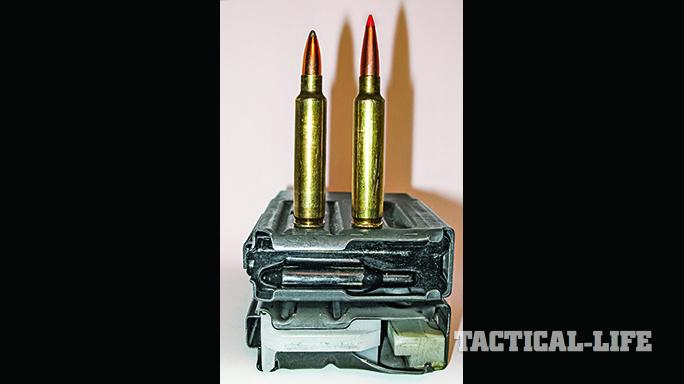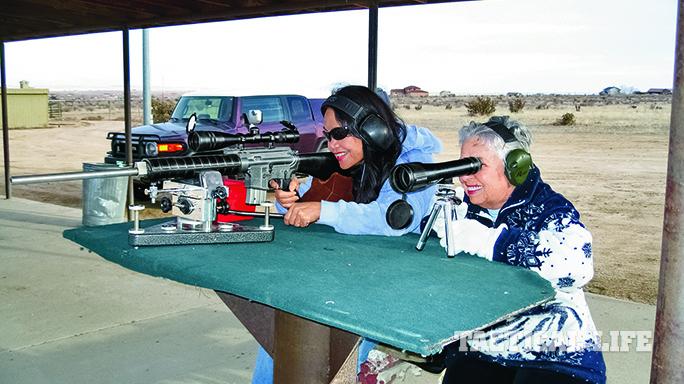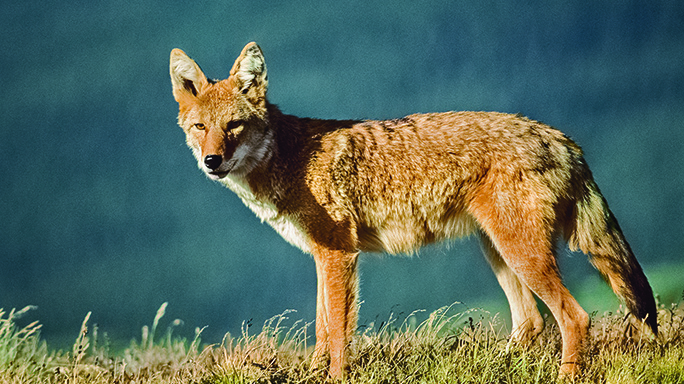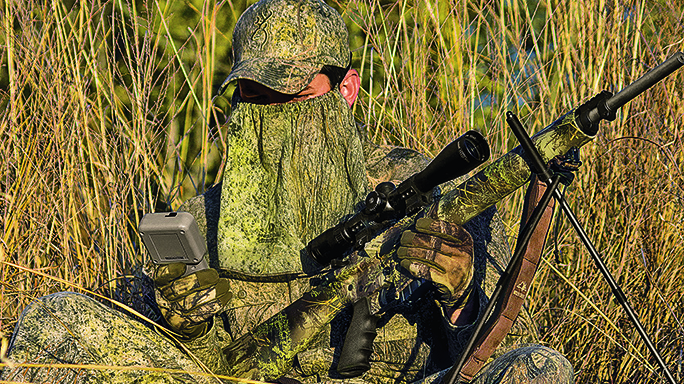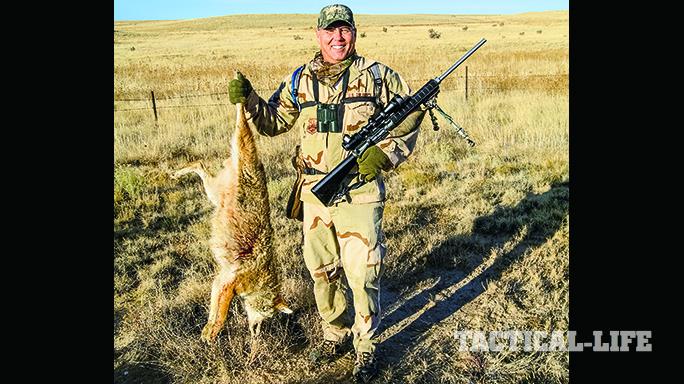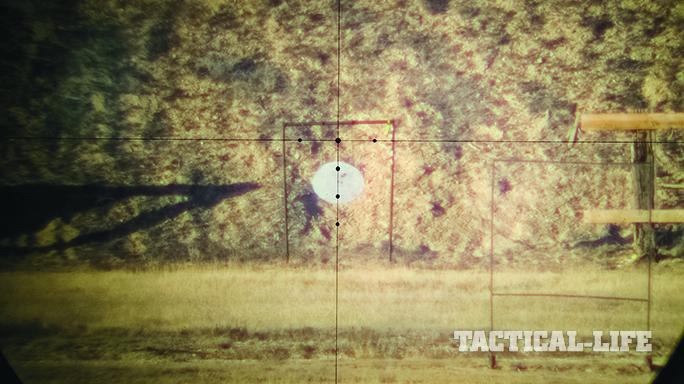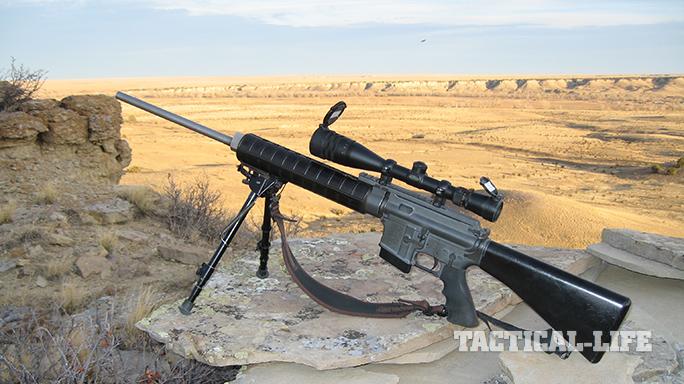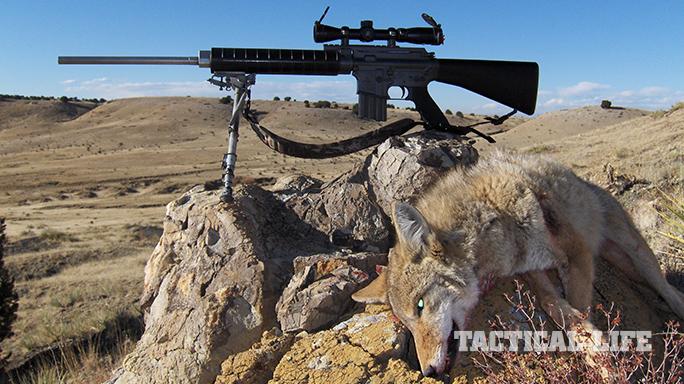I used to be a straight-up bolt-action guy when it came to varmint hunting, but when fellow varmint hunter Allan Marck called to tell me he had just purchased his first AR-15 for coyote hunting, and I saw the tight groups he was shooting with it, my eyes lit up like a Christmas tree.
The accuracy of many of today’s rigs cannot be denied. Coupled with the obvious quickness of the semi-auto follow-up shot, the AR-15’s applications for predator hunting leave most bolt-action guns wanting. I wish I had have known about these ARs when I was into putting as many furs on stretchers as I could years back. I’m sure many more would have ended up there. But I’m into something else these days—long range—and with the right system, these semi-autos can get to longer ranges with the best bolt actions, or at least close to them.
Insight Shooting Systems
Advertisement — Continue Reading Below
Allan’s varmint-hunting ARs were put together by one of the first AR-15 customizers in the country—Lee Mosher, founder of Insight Shooting Systems, Inc. (ISSI). While on a tour of duty in Vietnam years ago, Lee had plenty of time to do a critical analysis of his issued M16 from muzzle to buttstock. As a varmint hunter, he knew his M16 had the needed accuracy potential for small target applications. Once he got back stateside, he started putting ARs together to his specifications for varmint hunting.
- RELATED STORY: Watch – Hunting Coyotes with AAC’s MPW Carbine
He first milled off the carrying handle (basically creating one of the first civilian flat-topped ARs) and installed a high-powered scope. This way he could begin to extract the full accuracy potential from the rifle. Lee built his first black rifle way back in 1979, and aside from a barrel change here and there, he’s still using it to this day.
When I contacted Lee about my custom build, I told him that I needed something that would get me out to the longer varmint shooting ranges. He suggested a rifle with a 26-inch, 1-in-9-inch-twist Hart barrel chambered in the .223 Ackley Improved to get as much as possible out of it. I was actually taken aback a bit with the cartridge suggestion. I had worked with the improved version of the .223 before in a bolt gun, but I was surprised to find it would function in an AR. Lee said that he’d already done a few, and that feeding and functioning were not an issue as long as the correct chambering, reloading and cleaning techniques were adhered to. Besides that, the .223 Ackley Improved would give the bullet a little bit of extra velocity at the muzzle. I gave him the go-ahead then, and a couple of weeks later it was in my hands.
Advertisement — Continue Reading Below
Test Fire

At the time, I had a 4.5-14X Burris FFII scope with a Ballistic Plex reticle, so I mounted it on top in Burris Posi-Align rings. With the addition of a tall Harris bipod and sling, I was ready. Lee had done some preliminary testing with the rig and found that even fire-forming loads delivered tight groups right from the get-go. Consequently, I had 50 formed cases ready for load development. After full-length sizing the brass to fit, I loaded up some 69-grain Nosler Competition bullets and hit the range. Just about every load I ran down the bore was 0.75 MOA or less, with some loads grouping into very small clusters.
Some may question the choice of hollow-point match bullets I’ve used for this project, but when trying to overcome the 300-yard barrier consistently—on the first shot, in field conditions—I’ll take the higher-ballistic-coefficient (BC) bullets most of the time. But BC coefficient isn’t everything. It must be tempered with good terminal ballistics as well. Soft-point, polymer-tipped and thin jacketed-hollow-point bullets seem to work the best. I start at the 65-grain Sierra GameKing and work up from there. I have had some very good results with the 69-grain Nosler and Sierra MatchKing bullets as well, even as far out as 550 yards or so. The 75- and 80-grain Hornady A-MAX bullets should also work very well out to longer ranges. One of my favorite long-range bullets is the 65-grain JLK Low Drag now manufactured by Swampworks, Inc. That bullet is an excellent combination of light weight and high BC (very close to 0.4) that will get out to 500 yards about as well as anything.
All of these bullets require a faster rifling twist to stabilize them, though. Something in the 1-in-10- to 1-in-8-inch range is needed, depending on bullet. Some of them are also too long to fit in the standard AR-15 magazine. There is a solution to this problem, however. DPMS used to make a VLD magazine that was manufactured to allow about a quarter-inch more in a cartridge’s overall length than standard magazines will allow. It was designed to be used with a special bolt release that came with it.
Advertisement — Continue Reading Below
The guy that designed the magazine for a now-defunct company called Long-Range Shooting Products came up with a rather ingenious idea. What he did was open up the guide ridge in the back of the magazine so that a .223 case head could slide back into it. A couple of plastic inserts were glued into one side of the magazine that would allow the cartridges to be single-stacked one on top of the other. This really is a nice system and works great with my 65-grain Low Drag loads. Unfortunately, they are no longer being manufactured, but they can be had here and there on the Internet and at gun shows. But be sure to get the special bolt release as well. It won’t work without it. When used with my 65-grain Low Drag loads, this has proven to be a very formidable combination in the field out to longer ranges.
The Hornady Difference

Then there’s Hornady’s Superformance Varmint ammunition. The .223 Remington offering uses the 53-grain V-MAX bullet that was specifically designed to get the most downrange performance possible from this case capacity. When I saw the advertised whopping BC of 0.29, I just had to try them out in my AR. With a case full of Hodgdon’s Varget powder, I was able to achieve velocities exceeding 3,500 fps. That is smoking fast and should be approached with caution.
My groups so far have been hovering around 0.5 to 0.75 MOA all the way out to 425 yards, and should give me good terminal as well as external ballistics as far out as I would care to shoot a coyote. Only one coyote has fallen so far to this bullet at 140 yards, but it was devastating on impact. Although this bullet would be considered a “lightweight” compared to the others I’ve tested, the 0.29 BC is right at the edge of what I would consider capable for long-range hunting purposes.
Advertisement — Continue Reading Below
Going Long
In all the years I’ve been using the AR-15 afield for coyote hunting, about the best long-distance shooting I’ve ever seen accomplished with it—with any degree of consistency—is about 600 yards, and then only under the most ideal of conditions. It’s actually very easy to see what will happen in the field right from your computer screen. Just run any ballistics program for your load and see what kind of lateral dispersion you can expect when you enter only 1 mph of crosswind. Bullet BCs right around 0.3 to 0.5 at typical .223 velocities will still move about 4 inches laterally at 600 yards in those conditions. This seemingly minor windage change is barely perceptible at the shooter’s location, much less farther downrange. And on a broadside coyote whose vital zone measures only about 6 inches in diameter, that adds up to one tough shot even with the best of long-range equipment. Ranges past 600 yards are beyond the realm of feasibility for typical .223-based AR cartridges. If there is anyone out there who can dope field conditions consistently to this level of accuracy, I’ll skin their coyotes for them. For the average shooter, however, I’ll let the conditions dictate the limit of my shooting range. I’ll typically pass on the 500- to 600-yard shot if there is any perceptible air movement at all.
Not only does the shooter need to dope conditions to the highest level of accuracy possible, but the first shot needs to be as precise as possible under field conditions. This means right around 1-MOA precision as well as accuracy all the way out to 600 yards. Average morning-to-afternoon changes in air density (temperature, barometric pressure and humidity) will affect the established 600-yard zeros to some degree. When combined with the anticipated field accuracy level at that range, it’s quite the challenge to deliver first-shot connections every minute of every day on a 6-inch target. So pick your long-range shooting conditions wisely.
Advertisement — Continue Reading Below
Glass Selection

I have used four different optics on this rig so far that are good for long range. The aforementioned Burris with a Ballistic Plex reticle is a good system. Another optic that I dearly loved on this rig is the Pride Fowler 3-9X with a .22 LR Rapid Reticle. Before you laugh too much about this choice, the optic is actually very stout and made to very exacting tolerances. The reticle, though designed as a .22 LR-specific BDC reticle, can be easily adapted to any trajectory once the subtensions (measurements) of the stadia lines are known. When I first received the optic, I requested a schematic for the reticle with all the subtensions. Since subtension is often measured in MOA, it’s very simple to match it up to a ballistics program’s MOA calculations. In fact, I consider this to be one of the best BDC reticles ever designed.
Another optic I’ve used on this rig is the Bushnell 3200 Elite 4-12X with its older (now discontinued) Ballistic Reticle. This reticle is a tree reticle completely based on a 3-MOA system of reference all around. It’s worked well for me to ranges beyond 400 yards and is another good reticle system if you can still locate one online.
- RELATED STORY: Ready to Hunt – 5 Affordable Scoped Rifle Packages
During a recent coyote hunting season, a Weaver V-16 4-16X resided on top of my rifle. In 2009 and later catalogs, this optic has the option of several reticles, including the company’s Ballistic-X reticle, which is very similar to Burris’ Ballistic Plex, with four stadia points below the crosshair axis and horizontal plex post tips that can be used for windage references. The older catalogs advertised the various reticle subtensions, but this most recent edition does not. This is important information that is utilized for establishing long-range shooting systems and should always be included.
Advertisement — Continue Reading Below
Weaver’s reputation for putting out a good product is second to none for the price point. My V-16 was purchased several years ago and featured the Dual-X plex-style reticle. The optic’s features include a PA objective and quarter-inch, resettable, low-profile target turrets that have the reputation for excellent accuracy. I also wanted a ballistic reticle, so I sent it in to Michael O’Donnell at T.K. Lee Co., whom I’ve worked with many times in the past for custom reticles. The reticle was designed to my specifications using three 3-MOA dots that get progressively smaller along the reticle’s vertical axis below the center crosshair, and two dots on either side of the reticle’s axis at 4 MOA for windage. This is another reticle/scope combination that has served me well out to longer ranges on varmints.
Once the long-range dope is calculated from a ballistics program and tested, I put all the zeros on a sticker in 50-yard intervals. The sticker then goes into a Butler Creek ocular scope cap cover so it’s protected and can be quickly and efficiently referenced—critical for extremely mobile targets like coyotes. The system should be tested at the longer ranges, though, to ensure that the reticle zeros match up. Variations in muzzle velocity and bullet BC can cause slight errors that will not be apparent until ranges begin to stretch. So don’t expect a computer-generated ballistics profile to be perfect. Calculate it, test it, troubleshoot the calculations if necessary and then create a range sticker.
Field Notes

Tall Harris swiveling bipods are my choice for supporting the forend of the gun while shooting, as they provide for excellent stability and portability. When the greatest amount of accuracy is needed, I also use Darrell Holland’s Field Bag for a rear rest.
Advertisement — Continue Reading Below
I recently had an opportunity to put the system to the test. I only had the afternoon to hunt, so I gathered my gear and headed out to a local ranch. This particular location only encompasses about four sections, but it’s composed of some low bluff country that borders a river, so it’s almost always good for some coyote action. I parked the truck and made my way along the top of the bluffs, stopping to glass here and there. The last spot overlooked the river and as I was scanning around I spotted a dog slowly making his way toward me from the river. He appeared to be tired and shortly bedded down in some high grass. He was too far for a shot, though—at 820 yards according to my Geovids. But there was a ridge to my left that would allow for a closer shot if I could just get to it undetected. I gathered my gear and, as stealthily as possible, made my way towards the closer ridge.
Soon I found myself prone behind the AR on the bipod. There was just one problem: I couldn’t actually see the coyote from this different angle. I’d marked the spot earlier, though, and was hoping he was still there sleeping as before. I figured that if I howled at him, he just might sit up for a “look-see.” I lasered the bushes he was lying behind at 557 yards, cranked the scope up to 16X, adjusted the parallax appropriately, and noted that there wasn’t even a hint of a breeze—perfect! My reference according to the range sticker for the 65-grain Sierra load would be close to three dots down from the 225-yard crosshair zero. I was ready. A quick blast on the howler set the plan in motion, and when I put the scope to my eye I saw the dog just sitting there checking me out. I placed the interpolative zero on his chest and touched it off. The bullet spun up the barrel and out the muzzle at 3,150 fps. It negotiated the 557 yards to the dog in a half-second and flattened him. He began scrambling around then in an attempt to regain his footing, which he did momentarily before succumbing a second or so later.
This long-range dog stands as a testimonial to an accurately calculated, tested and practiced system, which are the keystones to successful long-range first-shot connections. Though the big appeal of ARs is their ability to send multiple projectiles downrange quickly, their inherent accuracy and ability to shoot higher-BC bullets effectively is attracting the fascination of long-range hunters and marksmen as well. From point-blank to about 600 yards, the AR-15 is a hard system to beat for the discriminating coyote hunter.
Advertisement — Continue Reading Below
For More Information
Burris Optics
burrisoptics.com; 970-356-1670
Bushnell
bushnell.com; 800-423-3537
Hornady
hornady.com; 800-338-3220
Weaver Optics
weaveroptics.com; 800-635-7656
This article was originally published in ‘AR Rifleman’ 2017. To pick up a copy, visit outdoorgroupstore.com.
